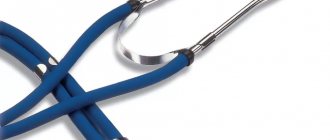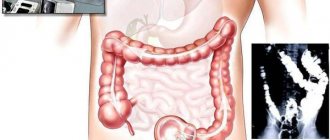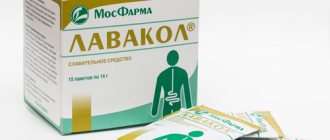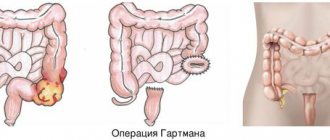Mesalazine is a drug for the basic treatment of ulcerative colitis, a mild form of Crohn's disease in some localizations, as well as a number of other diseases.
According to its chemical structure,
mesalazine is 5-aminosalicylic acid (5-ASA) , which has a local anti-inflammatory effect.
The drug affects the synthesis of pro-inflammatory prostaglandins and leukotrienes, slows down the migration, degranulation and phagocytosis of neutrophils, reducing the severity of inflammatory processes. Mesalazine has an antioxidant effect due to the binding of its molecules to free radicals. The drug is taken orally (orally) in the form of tablets, MMX tablets or granules, used in the form of an aerosol (rectal foam), suspension (microenemas) and suppositories. The anti-inflammatory effect of mesalazine is predominantly local (on the intestinal mucosa), so the concentration of the drug in contact with the intestinal wall and the time of this contact are important. Concentrations of the drug in the blood are usually minimal and do not affect its effectiveness.
The active ingredient in all these drugs is the same, but mesalazine is released in the intestinal lumen in different ways. This depends on the form of the drug, its shell and structure.
Below is a description of the main mesalazines registered in the Russian Federation.
Brief characteristics of mesalazine preparations
"Salofalk"
Production (Germany). In Russia it is presented in the form of tablets, granules, rectal foam, rectal suspension and suppositories.
A. Salofalk tablets
Salofalk tablets are coated with a protective enteric coating of Eudragit L, which provides pH-controlled release of mesalazine. The shell does not dissolve in gastric juice. But when it enters the intestine, where the pH level is ≥6.0, it is destroyed, and the active substance of the drug ends up in the intestinal lumen. In the terminal ileum, 15-30% of the drug is released, in the colon - 60-75%.
The release of mesalazine from Salofalk tablets begins in the terminal ileum 110-170 minutes after taking the drug, and after 4-5 hours, dissolution is completed in the descending colon. The release of mesalazine is not affected by changes in pH due to other medications or food intake.
About 10% of mesalazine is absorbed into the bloodstream, where it is quickly transformed into an inactive form and excreted from the body by the kidneys.
Forms of release and method of application
Salofalk tablets are available in doses of 250 mg and 500 mg. Take them in the morning, afternoon and evening 1 hour before meals. The tablets are swallowed without chewing and washed down with a sufficient amount of liquid.
b. Granules "Salofalk"
Salofalk granules are a two-component dosage form that combines pH-controlled release of mesalazine with long-term continuous release of the drug from a core based on an original polymer matrix. The enteric protective coating provides a pH-dependent release (at pH values ≥6.0) of the active substance, starting in the terminal ileum and continuing in the underlying intestine. The loss of the active substance to the ileum is minimal. The polymer matrix core ensures long-term continuous release of the active substance throughout the colon, right down to the rectum.
A large number of granules (3 g of Salofalk contain about 3500 granules) ensures a uniform and effective distribution of the active substance and, due to the very large surface area, maintains the effect even with diarrhea.
The drug reaches the ileocecal region after about 3 hours, and the ascending colon after 4 hours (faster than when taking Salofalk tablets). Approximately 80% of the oral dose reaches the colon, sigmoid and rectum. The amount of the drug that enters the blood and is excreted in the urine as a metabolite is less than when using Salofalk tablets.
Forms of release and method of application
Salofalk granules are available in doses of 500 mg and 1000 mg. The granules should be placed on the tongue and swallowed without chewing, with plenty of liquid. The prescribed dose of Salofalk in granules should be taken once a day, regardless of food intake.
V. Rectal foam (aerosol) “Salofalk”
Rectal foam (aerosol) “Salofalk” is a dosage form for rectal use, which allows for optimal contact of the active substance with the surface of the intestinal mucosa. Highly effective for active ulcerative colitis localized in the rectum, as well as for left-sided and widespread ulcerative colitis as part of combination therapy. When foam is administered through the rectum, mesalazine acts directly on the mucous membrane of the final sections of the colon. Due to the high adhesive ability of Salofalk foam, the drug can “stick” to the mucous membrane, which ensures long-term contact of mesalazine with the inflamed area of the intestine. And the duration of contact (exposure) increases the effectiveness of the drug.
Release form and method of application
Salofalk foam is produced in an aerosol can containing 14 applications of the drug, 1 g each, the set is equipped with 14 disposable soft applicators for insertion into the rectum. It is recommended to administer the drug before bedtime (preferably after a bowel movement), however, if there are frequent nighttime bowel movements, the attending physician may prescribe a different time.
Excerpt from the instructions for use of Salofalk rectal foam:
- At the time of administration, the drug should be at room temperature (20–25 °C)
- Place the applicator firmly on the cylinder head
- Shake the can for 20 seconds
- When using for the first time, remove the protective tab from the base of the dosing head.
- Turn the cap so that the semicircular cutout on the safety ring is in line with the nozzle. Place your index finger on the cap and turn the can upside down.
- Insert the applicator into the rectum as deeply as possible. It is best to place your foot on a chair or stool. In order to administer the first part of the dose of the drug, press the cap all the way and slowly release it. To administer the second dose of the drug, press the cap again and release slowly. Wait 10–15 seconds, then slowly remove the applicator from the rectum
- After introducing the foam, remove the applicator and throw it away in a plastic bag. For each new dose of the drug, a new applicator should be used.
- After the procedure, wash your hands. Try not to have a bowel movement until the next morning.
g. Rectal suspension "Salofalk" (microenema)
Rectal suspension "Salofalk" (microenema) is a ready-made suspension in a bottle with disposable applicators. The drug reaches the left (splenic) corner of the colon. In some patients, the drug reaches the transverse colon and even the ascending colon. When mesalazine is used in microenemas, low absorption of the drug is observed.
Forms of release and method of application
Microclysters "Salofalk" are available in doses of 2 g/30 ml and 4 g/60 ml. Smaller volume microenemas are suitable for patients who find it difficult to hold large volumes of suspension. The entire volume of microenemas is injected into the rectum at night (preferably after bowel movements), however, if there are frequent nighttime bowel movements, the attending physician may prescribe a different time.
d. Rectal suppositories "Salofalk"
Rectal suppositories "Salofalk" are suppositories intended for insertion into the rectum. They are used to achieve the highest concentration of mesalazine in this section of the intestine.
Forms of release and method of application
Rectal suppositories "Salofalk" are available in doses of 250 mg, 500 mg and 1000 mg (this dose is not registered in Russia). Suppositories are inserted into the rectum 1-2 times a day as prescribed by a doctor (preferably after bowel movements). It is usually recommended to administer the suppository at night, however, depending on the prescribed frequency of administration, combination with other local forms of therapy, as well as for nighttime bowel movements, the attending physician may prescribe a different time.
Due to the small size of the granules (about 1 mm), which facilitates unhindered passage through the stomach, they can be taken regardless of meals.
"Pentasa"
Production (Denmark). Presented in the Russian Federation in the form of tablets, granules and suppositories.
A. Pentasa tablets
Pentas tablets are enteric-coated. After administration, it disintegrates into microgranules coated with ethylcellulose. Microgranules act as independent forms of the drug with a slow release. This provides a therapeutic effect throughout the duodenum to the rectum, regardless of pH. The microgranules reach the duodenum within an hour after taking the tablet, regardless of food intake. The average passage time for the drug through the small intestine is 3-4 hours. About 30-50% of the dose taken is absorbed in the small intestine.
Release form and method of application
Pentasa tablets are available in doses of 500 mg. It is recommended to take after meals without chewing in 2-3 doses. The tablet can be split into several pieces or dissolved in water to make it easier to swallow.
b. Pentas granules
Pentas granules are microgranules coated with ethylcellulose. They act as independent forms of the drug with a slow release, which provides a therapeutic effect throughout the entire length from the duodenum to the rectum, regardless of pH. Microgranules reach the duodenum within an hour, regardless of food intake. The passage time of the drug through the small intestine is on average 3-4 hours.
Release form and method of application
Pentasa granules are available in doses of 1000 mg and 2000 mg. It is recommended to take the granules after meals without chewing. Pour the contents of one sachet onto your tongue and wash it down with water or juice.
V. Rectal suppositories "Pentas"
Pentasa rectal suppositories are suppositories intended for insertion into the rectum. They are used to achieve the highest concentration of mesalazine in this section of the intestine.
Release form and method of application
Rectal suppositories "Pentasa" are available in doses of 1000 mg. Externally they look like oblong tablets. Suppositories are inserted into the rectum 1-2 times a day as prescribed by a doctor, preferably after bowel movements. It is usually recommended to administer the suppository at night, however, depending on the prescribed frequency of administration, combination with other local forms of therapy, as well as in case of frequent nighttime bowel movements, the attending physician may prescribe a different time.
The drug can be moistened with water for easier administration.
"Mezavant"
Production (USA). Presented in the Russian Federation in the form of MMX tablets. MMX Mezavant tablets have a core containing mesalazine in a multicomponent matrix. The core is surrounded by a shell of methacrylic acid copolymers of types A and B. Mesalazine is released in the intestine only when the pH reaches >7. Scintigraphy studies have shown that after a single dose of 1.2 g of the drug on an empty stomach to healthy volunteers, mesalazine quickly and unchanged passes through the upper gastrointestinal tract. Traces of 14C-labeled mesalazine were detected throughout the colon. Complete disintegration of the tablet and release of mesalazine was observed after approximately 17.4 hours. After a single dose of 2.4 or 4.8 g to healthy volunteers for 14 days, mesalazine absorption was 21–22% of the dose taken.
Release form and method of application
MMX Mezavant tablets are available in a dose of 1.2 g (1200 mg). The entire recommended dose is taken 1 time per day with meals. The tablets should not be crushed or chewed and should be swallowed whole.
"Mesakol"
Manufacturing (India). Presented in the Russian Federation in the form of tablets. Mesacol tablets are coated with an enteric coating of Eudragit-L and Eudragit-S, which dissolves at pH>7. The bulk of mesalazine (60-79%) is released in the colon.
Forms of release and method of application
Mesacol tablets are available in a dose of 400 mg. The recommended dose of the drug is taken in 2-3 doses. The tablets should be taken before meals without chewing.
"Asakol"
Production (Switzerland). Presented in the Russian Federation in the form of tablets. Asakol tablets are coated with an enteric coating of Eudragit-S. Drug release begins in the colon at pH>7.
Forms of release and method of application
Asakol tablets are available in doses of 400 mg and 800 mg. The recommended dose of the drug is taken in 2-3 doses. The tablets should be taken before meals without chewing.
"Kansalazin"
Manufactured by Canonpharma Production CJSC (Russia). Presented in the Russian Federation in the form of tablets. The results of a study of the bioequivalence of the drug Cansalazine to the original drug mesalazine (manufactured by Danish) confirmed the full correspondence of the dynamics and concentration of mesalazine in the intestines when taking Kansalazine and the original drug. Thus, the manufacturer considers Kansalazine tablets to be a drug that has the same effect as Pentasa tablets.
Release form and method of application
Kansalazine tablets are available in doses of 500 mg. The recommended dose of the drug is taken in 2-3 doses. It is recommended to take the tablets after meals without chewing.
Irritable bowel syndrome: new horizons of drug therapy
A significant increase in the frequency of functional disorders of the digestive system in both adults and children has greatly contributed to the search for new approaches to the treatment of this group of diseases.
According to the generally accepted definition (according to DA Drossman, 1994), functional disorders of the digestive organs mean a varied combination of gastrointestinal symptoms without structural or biochemical disorders. At the same time, the essence of functional disorders is that they are based on a violation of the regulation of the functions of a particular organ, and not on the primary pathology of the target organ.
Among the many forms of functional disorders, irritable bowel syndrome (IBS) has attracted special attention for many decades, which is characterized by attacks of abdominal discomfort or abdominal pain that pass after defecation, associated with a change in the nature of stool or its frequency, without signs of inflammatory, metabolic, anatomical or neoplastic disorders and processes that could explain these symptoms (Rome III criteria, 2006). Additional symptoms may include difficulty defecating or a feeling of incomplete emptying of the rectum, excessive mucus discharge, rumbling or bloating.
According to the Rome criteria, clinical signs that speak in favor of IBS are also the variability and diversity of complaints, lack of progression, normal weight and general appearance of the child, increased complaints under stress, absence of symptoms at night, and association with other functional disorders. Pain often occurs before bowel movements and goes away after it. To a certain extent, the indicated lack of progression is controversial, since over time, chronic colitis can form against the background of IBS. An important criterion is also that abdominal pain or discomfort has been observed on at least 3 days of each month for the last 3 months.
Depending on the proportion of time during which changes in stool of one nature or another are observed (constipation or diarrhea), IBS is divided into IBS with constipation (IBS-C, IBS-C), IBS with diarrhea (IBS-D, IBS-D) , mixed IBS (IBS-M, IBS-Sm) and undifferentiated IBS (IBS-U, IBS-N).
Treatment of any disease should ideally be based on knowledge of its etiology and pathogenesis. Unfortunately, many aspects of the pathogenesis of functional disorders, including IBS, remain insufficiently studied. Nevertheless, the available data allow a fairly targeted approach to the issues of its therapy.
Traditionally, the cause of functional disorders of the gastrointestinal tract is seen in violations of the neurohumoral regulation of the motility of the digestive organs, associated with the psycho-emotional sphere, autonomic disorders and increased visceral sensitivity. In recent years, these key positions have been supplemented by new ones, the importance of which is widely debated. Such mechanisms, in particular, include inflammation.
The detection of an inflammatory process in IBS may cause some confusion, since its presence, in fact, contradicts the very concept of a functional disease. However, its development in IBS may be quite natural. On the one hand, inflammation can be secondary, i.e., a consequence of motility disorders, leading to a change in the composition of the internal environment in the intestinal lumen and damage to the mucous membrane. On the other hand, it may still be part of the structure of the disease itself, revealing features that distinguish it from other inflammatory bowel diseases. This feature is the predominance of mast cells in the cellular infiltrate, mainly in the area of nerve endings. This phenomenon has received a designation in the English-language scientific literature that can be translated as “low-grade mucosal inflammation.” An increase in the number of mast cells in patients with IBS in the small and large intestine has been identified in many studies [1–6], and one of them also showed an increase in the degree of their degranulation [4].
Mast cells are in close contact with nerve endings and can interact with them by membrane formations [7], and mast cell mediators (histamine, tryptase, prostaglandins, etc.) can affect the motility of the gastrointestinal tract [8]. However, what is particularly important is that this inflammation can lead to the development of visceral hypersensitivity, an important substrate of IBS [9]. Indeed, in some studies, a correlation was established between the degree of infiltration by mast cells of the mucous membrane and the nature of clinical manifestations, as well as the nature of psycho-emotional disorders [1, 2, 6, 10]. Moreover, a unique randomized controlled trial showed the effect of using 5-aminosalicylic acid in IBS, which correlated with a decrease in the severity of cellular infiltration in the colon mucosa [11].
The inflammatory process in question may be a consequence of an infectious process (acute intestinal infection in so-called post-infectious IBS), but also be caused by changes in the composition of the intestinal microflora, neurohumoral mechanisms (including stress) or food allergies. Established causes of the development of post-infectious IBS are infections with Campylobacter jejuni, Salmonella, Shigella, Escherichia coli and possibly some viruses [12].
The relationship between IBS and food allergies is interesting but controversial. Mast cells carry high-affinity IgE receptors on their surface [13], and their degranulation may cause IBS symptoms. Indeed, patients with food allergies exhibit a clinical picture similar to that of IBS [14] and a similar clinical picture is seen in systemic mastocytosis [15]. Moreover, drugs that stabilize mast cell membranes, such as sodium chromoglycate, have a positive effect on symptoms in IBS [16]. In a study by G. Mekkel et al. The incidence of IgE-mediated reactions in IBS has been shown to be approximately 34.5%. Among the most significant allergens are milk proteins, soybeans, tomatoes, peanuts, and egg whites [17]. At the same time, in IBS, reactions of intolerance to various nutrients that are not mediated by IgE are often detected. Clinicians are well aware of the common situation where it is difficult to understand whether IBS or food intolerance is primary. A patient with a food allergy, manifested by atopic dermatitis and/or bronchial asthma, often has a picture similar to IBS. Is it a manifestation of gastrointestinal allergies in addition to skin and respiratory symptoms, or is it IBS? It is not always possible to answer this question unambiguously without resorting to special research methods. However, available data indicate some commonality of effector mechanisms in both diseases. The results of studies concerning the relationship between food allergies and IBS are quite contradictory, and further study of this problem is required.
The interactions between the central nervous system and the gut are complex and not fully understood. It is well known that autonomic disorders significantly affect the motility of the gastrointestinal tract, often mediating the influence of the psycho-emotional sphere. Stress, mental disorders, and psychological abnormalities largely determine the state of the digestive organs, causing both functional and serious organic damage. At the same time, neurohumoral mechanisms also control inflammatory processes.
In particular, stress promotes the production of cortisol-releasing hormone, which affects intestinal motility, which has been shown in both animal and human studies [18, 19], as well as the processes of infiltration of the intestinal wall by mast cells in synergy with other neurotransmitters [20]. On the other hand, from the intestinal lumen, this same process is promoted by food antigens [21], as well as intestinal microflora, which through the immune system influences the pathological process in the intestinal wall [22].
Thus, the developmental mechanisms fit into a common structure linking the central nervous system, the intestinal nervous system, inflammation, immune responses and intestinal microflora.
Modern ideas about the pathogenesis of IBS have made it possible to propose several fundamental approaches to its treatment, which are advisable to combine in the process of treating the patient.
The first direction is the correction of psycho-emotional and vegetative disorders. Considering the key importance of these disorders in the pathogenesis of functional diseases of the digestive organs, special attention should always be paid to this area, involving, if possible, a psychologist, neurologist, or psychiatrist in the treatment. The range of both medicinal and non-medicinal approaches to solving the problem is very wide, and the choice of a specific approach is determined based on the individual characteristics of the patient. Among the drugs that affect the psychoemotional sphere in IBS (according to a meta-analysis), tricyclic antidepressants and serotonin reuptake inhibitors, in particular, have a significant positive effect on clinical manifestations [22].
The second direction is impact at the intestinal level.
Currently, in real practice, the most commonly used drugs are those that have an effect through various receptors of the gastrointestinal tract and thus regulate its motility.
5-hydroxytryptamine (serotonin) receptor agonists of the 4th subtype, which have significant pharmacological effectiveness at the level of the middle and distal parts of the intestine (tegaserod and prucalopride), have become widespread. The drug cisapride, widely used for many years, is currently discontinued due to identified side effects on the conduction system of the heart. A summary of a significant number of clinical trials of the next generation drug tegaserod in adult patients and adolescents with IBS-C showed that its use reliably leads to an increase in stool frequency and, in general, to a decrease in the severity of clinical manifestations of the disease [23]. However, this drug, although to a lesser extent, has potential cardiovascular side effects. Subsequent studies led to the development of the drug prucalopride, which is characterized by fairly high efficacy and a significantly lower incidence of side effects such as pain in the heart and diarrhea [24].
The development of visceral sensitivity-reducing 5-hydroxytryptamine subtype 3 receptor antagonists (alosetron) also offers interesting prospects, especially for the treatment of IBS with diarrhea.
The group under consideration also includes selective muscarinic receptor antagonists (such as zamifenacin and darifenacin) and beta3-adrenergic receptor antagonists (SR-58611 A, which is in development). A new direction is the use of cholecystokinin receptor blockers (CCKA receptors), which simultaneously have a stimulator of motilin receptors, the only representative of which is loxiglumide (and its dextrorotatory isomer dexloxiglumide), which has reached the stage of clinical trials today. The drug stimulates gastric and intestinal motility, reduces transit time through the colon, and also reduces visceral sensitivity [25].
Some time ago, erythromycin, a well-known drug from the macrolide group, as well as other 14-membered macrolides, were also used as a prokinetic agent. Erythromycin is also an agonist at motilin receptors on smooth muscle cells of the gastrointestinal tract. The drug accelerates gastric emptying and reduces intestinal transit time. In the colon, its influence is more pronounced in the ascending section compared to the descending section.
Another direction is the use of prosecretory drugs, in particular, the guanylate cyclase C agonist, Linaclotide, which is currently in phase 3 clinical trials. The drug is not absorbed in the intestine and has a stimulating effect on the chloride channels of the second type of cells in the intestinal mucosa, which causes increased secretion, increased volume and dilution of stool and, as a result, increased motility. Tests have shown its effectiveness in increasing the frequency of bowel movements in IBS-C, reducing pain, discomfort, and bloating. A side effect of the drug may be diarrhea caused by it [26]. The possibility of vomiting and pain in the heart area is also indicated [24], but the incidence of these side effects is relatively low [27].
Unfortunately, however, it should be noted that most of the drugs listed above are either in the development stage or are not available on the domestic market and all of them cannot be used in pediatric practice.
An exception is the opiate receptor agonist trimebutine.
Trimebutine (2-(dimethylamino)-2-phenylbutyl ester of 3,4,5-trimethoxybenzoic acid) was first synthesized by Laboratoires Jouveinal (France) in 1969. For many years, it has been and is used in various countries around the world for the treatment of functional gastrointestinal disorders. intestinal tract in children and adults.
Trimebutine (Trimedate®) is an agonist of peripheral opiate receptors of three main types (µ, δ, κ), located on smooth muscle cells throughout the gastrointestinal tract. The result of this is the modulating effect of trimebutine on the motility of the digestive system. In addition, it affects the visceral sensitivity of the digestive organs, providing a moderate analgesic effect, including in IBS. This effect is based on the influence of the drug on the antinociceptive system of the body with an increase in the threshold of pain sensitivity, modification of pain assessment, and a decrease in the sensitivity of receptors to inflammatory mediators. Moreover, trimebutine has a local analgesic effect [28, 29]. Trimebutine also affects the humoral regulation of gastrointestinal motility, increasing the secretion of motilin and reducing the levels of gastrin, glucagon, pancreatic polypeptide, insulin and vasoactive intestinal peptide [30].
Other pharmacological effects of trimebutine are reducing the pressure of the lower esophageal sphincter and accelerating gastric emptying. Due to its effect on various types of opiate receptors, trimebutine restores the normal physiological activity of the intestinal muscles, reducing it if it increases and vice versa, and therefore can be used for all forms of IBS.
A study of the prokinetic effects of trimebutine on healthy volunteers showed an acceleration of fluid evacuation from the stomach by 19% when taken orally at a dose of 200 mg per day and a modulating effect on the electrical activity of the gastrointestinal tract [31, 32]. According to JC Schang et al. after one month of treatment with trimebutine at a dose of 300 mg/day per os, stool frequency increased in 86% of patients with IBS-C [33]. Trimebutine at a dose of 400 mg administered intravenously was effective in postoperative intestinal paresis and shortened the time to recovery of intestinal motility in patients undergoing abdominal surgery [34]. In IBS with diarrhea, trimebutine eliminates increased intestinal motility, accelerates intestinal transit in case of constipation, reduces visceral hypersensitivity, and has an antispasmodic effect [30, 35].
Considerable experience has been accumulated in the use of trimebutine in pediatric practice. Thus, in an open study by C. Dupont et al. a significant positive effect of using trimebutine in children with functional disorders of gastrointestinal motility was shown [36].
Trimebutine is available in the form of tablets of 200 mg with one score and 100 mg with two marks. For children under 6 months of age, the drug is prescribed 12.5 mg 2-3 times a day, for children aged from 6 months to one year - 25 mg 2 times a day, for children 1-5 years - 25 mg 3 times a day. day, over the age of 5 years - 50 mg 3 times a day, children over 14 years of age and adults - 100-200 mg 3 times a day.
In our study, we intended to study the effect of the drug trimebutine (Trimedat®) on the electrical activity of various parts of the gastrointestinal tract in functional disorders in childhood. We used Trimedat® as part of complex therapy in 23 children (average age - 10.6 years) with functional disorders of the digestive organs. While taking the drug Trimedat®, multidirectional dynamics of electromyographic indicators were observed depending on the initial state of motor activity, leading to its restoration, which confirms the modulating (regulatory) effect of the drug. At the same time, Trimedat® influenced both the actual activity of myocytes and the activity of pacemakers [37].
Drugs that have an antispasmodic effect are also used to treat IBS, including K+ and Na+ channel blockers (for example, mebeverine), selective calcium channel inhibitors (for example, pinaveria bromide) and many others. A meta-analysis of the effectiveness of antispasmodics in IBS showed their significant positive effect on reducing abdominal pain and the overall severity of clinical manifestations [38].
In a significant number of cases with IBS, microbiocenosis disorders are detected, which can directly or indirectly affect intestinal motility, firstly, by changing the nature of metabolic processes in its lumen, and secondly, by promoting a low-active inflammatory process in the intestinal mucosa. In this regard, the use of drugs that affect the intestinal microflora may be pathogenetically justified. Among the antibiotics currently most recognized in this area of application is rifaximin. A meta-analysis found significant effectiveness compared with placebo in relieving IBS symptoms. Side effects are observed relatively rarely in the form of pain in the heart, vomiting, diarrhea and abdominal pain. The most serious of these occur in less than 1% of cases, and their frequency is no different from that in the case of placebo [39].
Pre- and probiotics have reliable effects, shown in meta-analyses, which have a positive effect on the general symptoms of IBS, abdominal pain and bloating [40, 41]. Dietary fiber has also been shown to be effective in treating constipation, but has little effect on pain symptoms in IBS [42]. For constipation, lactulose preparations (for example, Duphalac) are also widely used in pediatric practice, which have not only a laxative, but also a pronounced prebiotic effect. The use of combination products containing a prebiotic and butyric acid as a key metabolite of intestinal microflora necessary for normal colon function (for example, Zacofalk) may be promising. This direction requires further development.
Thus, the arsenal of drug therapy for IBS is quite diverse. It includes prokinetics (trimebutine in pediatric practice), antispasmodics, prebiotic laxatives, pre- and probiotics, and in some cases antibiotics. Further work in this direction will undoubtedly expand our understanding of the pathogenesis of IBS and provide new means for its effective treatment.
Literature
- Cremon C., Gargano L., Morselli-Labate AM, Santini D., Cogliandro RF, De Giorgio R., Stanghellini V., Corinaldesi R., Barbara G. Mucosal immune ac t ivat ion in irri table bowel syndrome: gender- dependence and association with digestive symptoms // Am J Gastroenterol. 2009. Vol. 104. P. 392–400.
- Piche T., Saint-Paul MC, Dainese R., Marine-Barjoan E., Iannelli A., Montoya ML, Peyron JF, Czerucka D., Cherikh F., Filippi J., Tran A., Hebuterne X. Mast cells and cellularity of the colonic mucosa correlated with fatigue and depression in irritable bowel syndrome // Gut. 2008. Vol. 57. P. 468–473.
- Walker MM, Talley NJ, Prabhakar M., Pennaneach CJ, Aro P., Ronkainen J., Storskrubb T., Harmsen WS, Zinsmeister AR, Agreus L. Duodenal mastocytosis, eosinophilia and intraepithelial lymphocytosis as possible disease markers in the irritable bowel syndrome and functional dyspepsia // Aliment Pharmacol Ther. 2009. Vol. 29. P. 765–773.
- Barbara G., Stanghellini V., De Giorgio R., Cremon C., Cottrell GS, Santini D., Pasquinelli G., Morselli-Labate AM, Grady EF, Bunnett NW, Collins SM, Corinaldesi R. Activated mast cells in proximity to colonic nerves correlate with abdominal pain in irritable bowel syndrome // Gastroenterology. 2004. Vol. 126. P. 693–702.
- Guilarte M., Santos J., de Torres I., Alonso C., Vicario M., Ramos L., Marinez C., Casellas F., Saperas E., Malagelada JR Diarrhoea-predominant IBS patients show mast cell activation and hyperplasia in the jejunum // Gut. 2007. Vol. 56. P. 203–209.
- Lee KJ, Kim YB, Kim JH, Kwon HC, Kim DK, Cho SW The alteration of enterochromaffin cell, mast cell, and lamina propria T lymphocyte numbers in irritable bowel syndrome and its relationship with psychological factors // J Gastroenterol Hepatol. 2008. Vol. 23. P. 1689–1694.
- Shanahan F., Denburg JA, Fox J., Bienenstock J., Befus D. Mast cell heterogeneity: effects of neuroenteric peptides on histamine release // J. Immunol. 1985. Vol. 135. P. 1331–1337.
- Gao C., Liu S., Hu HZ, Gao N., Kim GY, Xia Y., Wood JD Serine proteases excite myenteric neurons through protease-activated receptors in guinea pig small intestine // Gastroenterology. 2002; 123:1554–1564.
- Spiller RC Overlap between irritable bowel syndrome and inflammatory bowel disease // Dig Dis. 2009. Vol. 27. Suppl 1. P. 48–54.
- Barbara G., Wang B., Stanghellini V., de Giorgio R., Cremon C., Di Nardo G., Trevisani M., Campi B., Geppetti P., Tonini M., Bunnett NW, Grundy D., Corinaldesi R. Mast cell-dependent excitation of visceral-nociceptive sensory neurons in irritable bowel syndrome // Gastroenterology. 2007. Vol. 132. P. 26–37.
- Corinaldesi R., Stanghellini V., Cremon C., Gargano L., Cogliandro RF, De Giorgio R., Bartesaghi G., Canovi B., Barbara G. Effect of mesalazine on mucosal immune biomarkers in irritable bowel syndrome: a randomized controlled proof-of-concept study // Aliment Pharmacol Ther. 2009. Vol. 30. P. 245–252.
- De Giorgio R., Barbara G. Is irritable bowel syndrome an inflammatory disorder? // Curr Gastroenterol ReP. 2008. Vol. 10.Vol. 385–390.
- Ohman L., Simren M. Pathogenesis of IBS: role of inflammation, immunity and neuroimmune interactions // Nat Rev Gastroenterol Hepatol. 2010. Vol. 7. P. 163–173.
- Brandtzaeg P. Food allergy: separating the science from the mythology//Nat Rev Gastroenterol Hepatol. 2010. Vol. 7. P. 380–400.
- Valent P. Systemic mastocytosis // Cancer Treat Res. 2008. Vol. 142. P. 399–419.
- Klooker TK, Braak B., Koopman KE, Welting O., Wouters MM, van der Heide S., Schemann M., Bischof f SC, van den Wijngaard RM, Boeckxstaens GE The mast cell stabilizer ketotifen decreases visceral hypersensitivity and improves intestinal symptoms in patients with irritable bowel syndrome // Gut. 2010. Vol. 59. P. 1213–1221.
- Mekkel G., Barta Z., Ress Z., Gyimesi E., Sipka S., Zeher M. Increased IgE-type antibody response to food allergens in irritable bowel syndrome and inflammatory bowel diseases // Orv Hetil. 2005. Vol. 146. No. 17. P. 797–802.
- Bradesi S., Eutamene H., Garcia-Villar R., Fioramonti J., Bueno L. Acute and chronic stress differentially affected by visceral sensitivity to rectal distension in female rats // Neurogastroenterol Motil. 2002. Vol. 14. P. 75–82.
- Fukudo S. Role of corticotropin-releasing hormone in irritable bowel syndrome and intestinal Philpott H., Gibson P., Thien F. Irritable bowel syndrome — An inflammatory disease involving mast cells // Asia Pac Allergy. 2011; 1:36–42. Inflammation // J Gastroenterol. 2007. Vol. 42 Suppl. 17. P. 48–51.
- Keita AV, Soderholm JD The intestinal barrier and its regulation by neuroimmune factors // Neurogastroenterol Motil. 2010. Vol. 22. P. 718–733.
- Tobin MC, Moparty B., Farhadi A., DeMeo MT, Bansal PJ, Keshavarzian A. Atopic irritable bowel syndrome: a novel subgroup of irritable bowel syndrome with allergic manifestations // Ann Allergy Asthma Immun. 2008. Vol. 100. P. 49–53.
- Ruepert L., Quartero AO, de Wit NJ, van der Heijden GJ, Rubin G., Muris JW Bulking agents, antispasmodics and antidepressants for the treatment of irritable bowel syndrome // Cochrane Database Syst Rev. 2011. Aug 10 (8): CD003460.
- Evans BW, Clark WK, Moore DJ, Whorwell PJ Tegaserod for the treatment of irritable bowel syndrome and chronic constipation // Cochrane Database Syst Rev. 2007. Oct 17 (4): CD003960.
- Gale JD The use of novel promotility and prosecretory agents for the treatment of chronic idiopathic constipation and irritable bowel syndrome with constipation // AdvTher. 2009. Vol. 26. No. 5. P. 519–530.
- Scarpignato C., Pelosini I. Management of irritable bowel syndrome: novel approaches to the pharmacology of gut motility // Can J Gastroenterol. 1999. Vol. 13 Suppl. A: 50 A–65 A.
- Wensel TM, Luthin DR Linaclotide: A Novel Approach to the Treatment of Irritable Bowel Syndrome // Ann Pharmacother. 2011. Nov 1. .
- Lembo AJ, Kurtz CB, Macdougall JE, Lavins BJ, Currie MG, Fitch DA, Jeglinski BI, Johnston JM Efficacy of linaclotide for patients with chronic constipation // Gastroenterology. 2010. Vol. 138. No. 3. P. 886–895.e1. Epub 2010 Jan 4.
- Schang JC, Devroede G., Pilote M. Effects of trimebutine on colonic function in patients with chronic idiopathic constipation: evidence for the need of a physiologic rather than clinical selection // Dis Colon Rectum. 1993. Vol. 36. No. 4. P. 330–336.
- Roman FJ, Lanet S, Hamon J et al. Pharmacological properties of trimebutine and N-monodesmethyltrimebutine // J Pharmacol Exp Ther. 1999. Vol. 289. N3. P. 1391–1397.
- Delvaux M., Wingate D. Trimebutine: mechanism of action, effects on gastrointestinal function and clinical results // J Int Med Res. 1997. Vol. 25. No. 5. P. 225–246.
- Taniyama K., Sano I., Nakayama S. et al. Dual effect of trimebutine on contractility of the guinea pig ileum via the opioid receptors // Gastroenterology. 1991. Vol. 101. No. 6. P. 1579–1387.
- Grandjouan S., Chaussade S., Couturier D. et al. A comparison of metoclopramide and trimebutine on small bowel motility in humans // Aliment Pharmacol Ther. 1989. Vol. 3. No. 4. P. 387–393.
- Schang JC, Muller J., Rico E., Grenier JF Accelerator effects of Debridat (trimebutine) on duodenal transit // Med Chir Dig. 1982. Vol. 11. No. 5. P. 371–374.
- Walters JM, Crean P., McCarthy CF Trimebutine, a new antispasmodic in the treatment of dyspepsia // Ir Med J. 1980. Vol. 73. No. 10. P. 380–381.
- Kountouras J. Efficacy of trimebutine therapy in patients with gastroesophageal reflux disease and irritable bowel syndrome // Hepatogastroenterology. 2002. Vol. 49. No. 43. P. 193–197.
- Dupont C. Effect du Trimebutine dans les colopathies fonctionnelles de l'enfant // Medicine Enfance. 1982. Vol. 2. P. 6.
- Belmer S.V., Gasilina T.V., Kovalenko A.A., Karpina L.M. Modern ways of correcting functional disorders of the digestive organs in children // Questions of pediatric dietology. 2011. No. 2. P. 10–14.
- Ruepert L., Quartero AO, de Wit NJ, van der Heijden GJ, Rubin G., Muris JW Bulking agents, antispasmodics and antidepressants for the treatment of irritable bowel syndrome // Cochrane Database Syst Rev. 2011. Aug 10; (8): CD003460.
- Menees SB, Maneerattannaporn M., Kim HM, Chey WD The Efficacy and Safety of Rifaximin for the Irritable Bowel Syndrome: A Systematic Review and Meta-Analysis // Am J Gastroenterol. 2011. Nov 1.
- Whelan K. Probiotics and prebiotics in the management of irritable bowel syndrome: a review of recent clinical trials and systematic reviews // Curr Opin Clin Nutr Metab Care. 2011. Vol. 14. No. 6. P. 581–587.
- Nikfar S., Rahimi R., Rahimi F., Derakhshani S., Abdollahi M. Efficacy of probiotics in irritable bowel syndrome: a meta-analysis of randomized, controlled trials // Dis Colon Rectum. 2008. Vol. 51. P. 1775–1780.
- Bijkerk CJ, Muris JW, Knottnerus JA, Hoes AW, de Wit NJ Systematic review: the role of different types of fiber in the treatment of irritable bowel syndrome // Aliment Pharmacol Ther. 2004. Vol. 19. P. 245–251.
S. V. Belmer, Doctor of Medical Sciences, Professor A. A. Kovalenko, Candidate of Medical Sciences T. V. Gasilina, Candidate of Medical Sciences A. N. Akopyan N. M. Narinskaya
GBOU VPO RNIMU im. N. I. Pirogova Ministry of Health and Social Development of the Russian Federation, Moscow
Contact information for authors for correspondence
Indications for the use of mesalazine
Many patients with ulcerative colitis and Crohn's disease are familiar with this drug under various commercial names (Salofalk, Pentasa, Mezavant, Mesacol, Asacol, etc.).
Most often, these drugs are prescribed for inflammatory bowel diseases (IBD), primarily ulcerative colitis .
Mesalazine and ulcerative colitis
According to the Russian and European recommendations of 2022, mesalazine is a drug for the basic treatment of ulcerative colitis of any localization. Clinical studies have shown that all commercial forms of mesalazine are equally effective in the treatment of ulcerative colitis.
Then what is their difference? Why do some patients benefit from pH-dependent release mesalazine granules, others from slow-release tablets, and some do not get better at all?
Undoubtedly, there are differences in the drugs. In the section with general characteristics of mesalazines, the mechanisms of release of the active substance from tablets and granules are discussed in sufficient detail. Sometimes the release and uniform distribution of the drug throughout the intestine is affected by the acidity (i.e., the same pH) in the intestine. In other cases, the release of mesalazine is independent of pH but is dependent on intestinal transit time. In pathological conditions, pH values can vary greatly and differ from the norm. Thus, according to the results of one study (on a limited group of healthy individuals), pH values did not reach 7 in any part of the gastrointestinal tract in 25% of cases. In 90% of cases (again, not in all study participants), the pH exceeded 6. That is, there is a possibility that in a number of patients with ulcerative colitis and Crohn's disease, mesalazines with a pH-dependent release system (Salofalk, Mesacol, Asacol, Mezavant) may be less effective than expected. When using pH-independent mesalazines (Pentasa, Canasalazine), researchers note that most of the drug begins to be released in the small intestine, which means there is a possibility that the concentration of mesalazine in the colon will be less than necessary to achieve an effect. In some cases, this probability can be reduced by increasing the dose of the drug.
The dose of mesalazine prescribed is another factor in the success or failure of IBD treatment. An insufficient dose of the drug leads to a poor response to therapy.
It is important to correctly assess the location of intestinal damage. It is this (proctitis, left-sided or widespread/total ulcerative colitis) that determines the choice of the dosage form of mesalazine (tablets, granules, foam, microenemas or suppositories). For example, suppositories can be used in first-line therapy for ulcerative colitis affecting the rectum.
Finally, mesalamines may not have the expected benefit due to high disease activity. In this case, they are combined with other drugs (including hormonal agents and immunosuppressants).
Summarizing the above, we can conclude:
Good knowledge of the mechanism of action of drugs and the capabilities of various dosage forms allows a gastroenterologist to select an individual treatment regimen for the patient.
Mesalazine and Crohn's disease
A few words about Crohn's disease and the effectiveness of mesalazine in its treatment. Until 2016, when the update of the European consensus on the diagnosis and treatment of Crohn's disease (3rd revision) was published, mesalazine was recommended for mild forms of the disease affecting the large intestine (Crohn's colitis) and small intestine (Crohn's ileitis). In the first case, the use of large doses of mesalazine (3-4 g per day) with a pH-dependent release system was recommended, in the second - mesalazine with a pH independent release system (Pentasa) at a dose of 4 g per day. Changes to the treatment strategy were made after publication of the consensus. This also influenced Russian recommendations related to the diagnosis and treatment of Crohn's disease. Mesalazine is found to be ineffective compared to placebo. However, clinical practice shows that for patients with mild disease, taking mesalazine helps, up to the healing of the mucous membrane.
Mesalazine can also be prescribed for chronic colitis of unknown or unspecified origin, radiation (radiation) colitis, diverticular disease of the intestine, etc.
Principles of treatment of inflammatory bowel diseases
Drug (conservative) therapy for ulcerative colitis and Crohn's disease is carried out not only to eliminate the symptoms of the disease with which a person went to the doctor.
The goal of treatment is to reduce the frequency and severity of exacerbations and prevent the development of complications, which may require major surgery. All medications prescribed for inflammatory bowel diseases are conventionally divided into drugs for rapid elimination of exacerbation (induction of remission) and for long-term control of the disease (maintenance of remission). Remission is a period of the disease during which there are no manifestations associated with active inflammation. For example, with ulcerative colitis, remission is said to occur when the frequency of stools is less than 3 times a day and there is a complete absence of blood in the stool.
In recent years, it has become clear that the most favorable course of inflammatory bowel disease (IBD) occurs in people who managed not only to eliminate the external manifestations of the disease (achieve clinical remission), but also to induce complete healing of the intestine with medications (endoscopic remission). Therefore, in order to objectively check whether treatment is effective, doctors perform control endoscopic examinations and also use laboratory tests, for example, a stool test for calprotectin.
In addition, modern therapy aims to minimize the frequency of use of glucocorticosteroid hormones, since their long-term use not only does not control ulcerative colitis or Crohn's disease, but is also accompanied by side effects that may remain even after stopping their use. One of the main goals of modern treatment of IBD is to achieve steroid-free remission. The rapid resumption of symptoms of the disease after an initial improvement while taking hormones indicates hormonal dependence and always requires increased drug therapy and sometimes surgery.
In the treatment of IBD the following are used:
- Anti-inflammatory drugs of the aminosalicylate group. They have nothing to do with acetylsalicylic acid, that is, aspirin. The place of their action: mainly the mucous membrane - the inner layer of the intestine. For this reason, they are used successfully for ulcerative colitis, but rarely help with Crohn's disease, in which inflammation spreads beyond the mucous membrane.
- Local (topical) glucocorticosteroids. A natural glucocorticosteroid - the adrenal hormone cortisol - is secreted daily in the body of any person. These hormones suppress the immune system and also affect almost all organs and mechanisms regulating the body’s vital functions, controlling the metabolism of sugar, fat and protein, blood pressure, and the release of fluid from the body. Topical hormones hardly enter the blood, being very quickly absorbed into the damaged mucous membrane and providing a local anti-inflammatory effect.
- Systemic glucocorticosteroids have a powerful anti-inflammatory effect and are prescribed for moderate and severe forms of IBD. If a person cannot take the pills, or symptoms need to be relieved as quickly as possible (for example, with severe ulcerative colitis), these drugs are given intravenously. Systemic hormones cause multiple side effects, including fat redistribution, weight gain, diabetes mellitus, hypertension, osteoporosis, thrombosis, and even psychosis. Systemic hormones are always used in a short course and are used only to induce remission. These drugs are not suitable as permanent therapy: experts recommend completing hormonal therapy within 12 weeks.
- Mild immunosuppressants. These drugs inhibit cell division. Immunosuppressants have an indiscriminate (non-selective) effect on immune cells, thereby significantly increasing the likelihood of all kinds of infections. In addition, the drugs slightly increase the risk of skin cancer and another malignant disease - lymphoma. These medications accumulate in the body slowly and are therefore used only to maintain remission. Until they “work”, a patient with an exacerbation of IBD is usually prescribed topical or systemic hormones.
- Powerful immunosuppressants. These drugs also suppress cell division, but act quickly. When treating severe forms of ulcerative colitis, these drugs sometimes avoid removal of the colon when hormones are ineffective.
- Biological drugs. These are protein drugs that block the action of specific molecules involved in the formation of chronic inflammation. Biologics are indicated for patients with moderate to severe active IBD who have failed other therapy or are at high risk for complications. Biological drugs vary depending on the specific proteins they target. They are effective for both induction and maintenance of remission.
In addition, in addition to the main drugs, auxiliary treatment is used, mainly for complications of the disease or to prevent complications of the treatment itself.
Often patients require a combination of several drugs.
When choosing treatment, the specialist takes into account the clinical symptoms, course and severity of the disease, as well as the presence and nature of complications. IBD is a chronic disease that can be controlled. It is important to discuss your treatment with your doctor and strictly follow the prescribed treatment regimen.
*Does not replace medical advice. To make a diagnosis and prescribe treatment, you must consult a specialist.
Side effects when using mesalazine
The side effects of mesalazine are described in sufficient detail in the official instructions for the drug, however, in general, the drug is well tolerated even in large doses and with long-term use (in 93-98% of patients).
Immediate allergic reactions (soft tissue swelling, Quincke's edema, anaphylaxis) when taking mesalazine range from 0.07 to 0.1% of cases.
The risk of allergic reactions generally increases in patients with bronchial asthma.
The drug is toxic to the liver, pancreas and bone marrow. Drug-induced liver damage and clinically insignificant changes in liver tests (increased ALT and/or AST) when taking mesalazine occur in 2.6-4% of cases. Toxic pancreatitis (inflammation of the pancreas) is observed even less frequently - less than 1% of cases.
Mesalazine, pregnancy and breastfeeding
In the article “Frequently Asked Questions on IBD,” we looked at the problem of conception, pregnancy and delivery in ulcerative colitis and Crohn’s disease.
These diagnoses are not a death sentence at all; patients with IBD can become pregnant and give birth. At the same time, the patient may need to continue taking mesalazine even during pregnancy.
The effect of mesalazine on conception
There is no data on the effect of mesalazine on the ability of men to conceive (unlike, for example, sulfasalazine).










